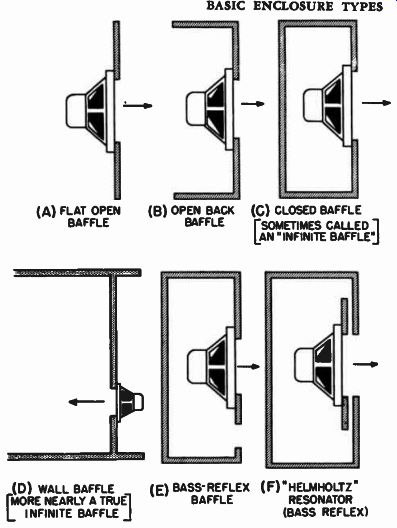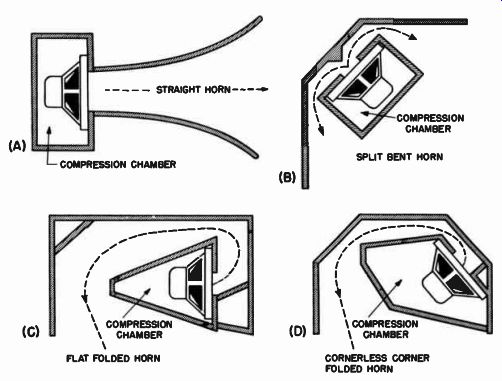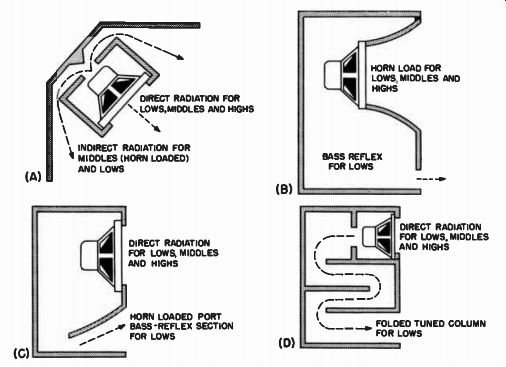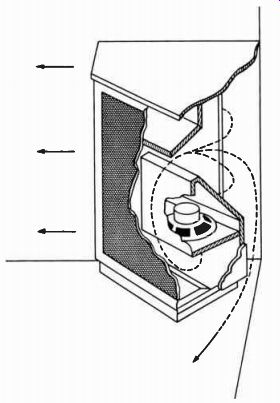PART 2 THE ENCLOSURE
SECTION 8: Basic Enclosure Types
The Enclosure is an Acoustic Circuit for the Loudspeaker
An essential part of any loudspeaker system is the enclosure in which the loudspeaker is to be used. An enclosure for a loudspeaker is often called a baffle, and perhaps technically speaking, baffle is a more descriptive word than enclosure, as the reader will soon see. The prime purpose of any enclosure is to provide the proper acoustic circuit for the loudspeaker to work with, so that maximum efficiency and best performance may be obtained from the combination. In the effort to provide this acoustic circuit, the sound coming from the loudspeaker is routed into certain paths and prevented from going into other paths by blank walls put in its way.
Thus the term "baffle" as used in a technical sense connotes a means of routing the sound energy. Since most of today's baffles are built into more or less complex box-like structures (even though the box may contain a horn), the words enclosure and bee are used inter changeably. However, in certain instances, we shall specifically use the word baffle because in no sense will the word enclosure describe the function of the unit. This situation will arise in the discussion of horn tweeters as baffle crossover elements, for the horn is directly and precisely a baffle rather than an enclosure.
The choice of the proper enclosure or baffle for a desired loud speaker system is governed by several factors. These factors are the speaker size, the performance range expected from the speaker-enclosure combination, and the manner in which the speaker is to be operated.
The speaker-enclosure combination may be of the direct radiator type (such as the bass-reflex enclosure), of the indirect radiator type (such as the horn), or a combination of the two. Variations of these basic types are illustrated in Figs. 8-1, 8-2, and 8-3 respectively. We shall examine here the general differences between these basic types, and subsequent chapters will provide a more detailed study of each.
Direct Radiator: Speaker Works Directly Into Listening Space
As will readily be seen from Fig. 8-1, the direct radiator enclosure allows the loudspeaker diaphragm to be directly exposed to the surrounding atmosphere in which the sound is to be heard. The loudspeaker radiates directly into the listening area. There are no intervening acoustic elements between the loudspeaker and the ear other than the air itself. Despite the fact that there are no restraining elements upon the forward propagation of the sound, there may however, be some drastic modification made upon the overall performance of the system by the degree to which the rear of the speaker is enclosed. Here again, the word "enclosed" is used rather loosely. For instance, the loudspeakers shown in (A) and (B) of Fig. 8-1, are by no means enclosed. They are baffled, however, to the extent that the sound from the back of the speaker is prevented from spreading around to the front of the speaker by the extent to which the open baffle walls prevent it from spreading.
Enclosures Improve Low Frequency Response
Although open baffles of this nature are not usually encountered in present day high-fidelity practice, a brief discussion of them will illustrate two important points concerning enclosures. The first consideration, and the one more commonly appreciated, is that the purpose of the baffle or enclosure is to improve the low frequency response of the loudspeaker. The baffle accomplishes this by minimizing rear-to front cancellation of the energy coming from the loudspeaker. If there were no obstruction in the way of such roundabout circulation of the acoustic energy, the loudspeaker would be virtually "short circuited" upon itself. As soon as the diaphragm moved forward, pushing out ...

Fig. 8-1. Forms of direct radiator baffles. The face of the diaphragm
feeds directly into open space.
... a forward pulse of sound, the rear of the diaphragm would create a momentary vacuum in the back, thereby sucking in the sound the front of the diaphragm was trying to push out. Such short circuiting of the sound from the front to the back would simply result in no sound being propagated. This effect is most pronounced at the low frequencies because it takes a comparatively long time for a low frequency wave to become established in the air, and the longer this takes the more easily the wave is destroyed by the rear "pulling-in" process.
Obviously, if the low frequency wave is given an opportunity to build itself up in space before it is sucked into the rear, there will be an improvement in low frequency sound propagation. Any wave, radio or sound, once it has been produced in open space will tend to radiate outward from its source. One way of encouraging the buildup of the low frequency wave from a loudspeaker is to put some obstacle in its path so it cannot get back to the rear of the speaker. This is precisely what the flat baffle and the folded open baffle of Fig. 8-1 accomplish.

Fig. 8-2. Forms of indirect radiator baffles. The horn element is inter
posed between listening area and diaphragm. Compression chamber seals
off rear of diaphragm. { Parts (C) and (D) after University}
These baffles elongate the path from front to rear of the speaker and thereby give the sound a chance to develop into some sort of wave motion before being pulled in around the back. Since low frequencies are long wavelengths, it follows that the longer the baffle length the lower will be the minimum frequency the loudspeaker can radiate before destructive front-to-rear cancellation takes place. This explanation of the baffle effect is considerably simplified, however. In the next sectionwe will discuss the "dipole" effect, which explains baffles in a more technically accurate manner.

Fig. 8-3. Combinations of direct and indirect radiators.
Enclosure Shape Affects Performance
The second property of the baffle is to act as a radiating surface itself in addition to the loudspeaker. This statement should absolutely not be interpreted to mean that the baffle should vibrate. It should, on the contrary, be as rigid and non-vibratable as possible, so that it will not wastefully absorb sound power. As the sound comes out of the loudspeaker and spreads out, hitting the outside surface of the baffle, it literally should meet a hard immovable wall that will immediately bounce the sound energy into the listening area where it is needed. Thus the disposition of the baffle surfaces is as important as the length of the baffle.
Figure 8-4 shows two baffles, a conventional flat one and an unconventionally open folded one. Although the length of the baffle walls of both these systems may be identical, the extremely folded one will have considerably poorer low frequency response than the flat open one. The flat baffle will act as an auxiliary "springboard" for the sound wave being built up in front of it, and give the sound wave an added send-off into space. On the other hand, the extremely folded baffle will permit the sound wave being developed to fall in immediately on the sides of the baffle. Now, although the wave energy will not be ...

Fig. 8-4. Baffle shape is as important as baffle size. Baffle (A) will
provide proper "sounding board" action and develop good radiation.
Baffle (B) will allow wave motion to diffract around the sides and wave
formation will be deteriorated. This baffle may also become tuned to one
frequency depending upon its length.
POOR WAVE FORMATION ( B) GOOD WAVE FORMATION ( A )
... absorbed into the back of the speaker in this baffle any more than it was in the flat baffle, it is difficult for that wave motion to be established, because of this "falling back" process. In more technical terms, the small front surface of the above open folded baffle permits "diffraction" to take place around the baffle for long wavelengths, which deteriorates the setting up of the wave motion.
There is still another peculiarity of such an extreme baffle shape.
In the shape in which it is shown, this baffle actually represents a long tube, which may become resonant (like an organ pipe) to a very small band of frequencies whose wavelengths correspond to a multiple of the length of the baffle "tube." Thus, instead of giving smoothed-out low frequency response, as should be expected from a good baffle, a baffle such as this may give a very peaked narrow band response. However, when properly matched to the resonance of the speaker and en closed in a structure that has a reasonably large front surface as well, this tuned tube may give quite good low frequency response. Such an enclosure is the folded tuned column type shown in Fig. 8-3 (D). It will thus be seen that the shape of the baffle is as important as its size.
The shape of the baffle is an important factor not only in the low frequency region, but in the high frequency area as well. The shape of a high frequency horn, which is fundamentally a baffle, has a great deal to do with the manner in which the high frequencies are distributed throughout the listening area. The shape of the horn and its flares will greatly determine the degree to which the necessary high frequency wide angle coverage is obtainable.
These factors (rigid non-vibratable panels, size of enclosure, and shape of enclosure) are thus important aspects of baffle design and will be treated in detail in Section 14.
Completely Closed Enclosure Stops Front to Rear Cancellation
Let us return to the concept of the elongated baffle path making it difficult for the front propagating wave to reach the back of the loudspeaker. It is obvious that by completely enclosing the back of the speaker we get an infinite degree of blocking of the front wave. Such an enclosure is therefore often called an infinite baffle, although in a strict technical sense, the term is not accurate. An infinite baffle is one that presents an infinitely large baffle surface and rear volume to the speaker. Referring to (C) of Fig. 8-1, it will be immediately apparent that a closed box, if small in size, falls far short of presenting to the loudspeaker either an infinitely large baffle surface or an in finitely large rear volume. In fact, if this box is made small enough, it may literally function in a manner opposite to that of a true infinite baffle.
It is of course a physical impossibility to obtain an infinitely large baffle surface and rear volume. These are only theoretical terms; but, for practical purposes, they may be effectively approximated within reasonable dimensions to give performance close to what a true in finite baffle would produce. If our closed box were made quite large, if it were, for example, a large closet or another room with the speaker mounted in the intervening wall, as in (D) of Fig. 8-1), it would very nearly constitute an infinite baffle. There would be no rear-to- front wave cancellation. Furthermore, the baffle surface would be so large that it would provide more than enough active surface to allow the lowest frequency of which the speaker is capable to develop fully into a well established wavefront.
One thing will immediately be obvious from the above discussion.
It is necessary to "enclose" the speaker in order to get good low frequency response. However, when taken to the extreme, a completely enclosed box structure or a wall structure will completely prevent the use of the sound from the rear of the speaker. This rear energy is lost as far as useful acoustic output is concerned. One way of overcoming this, among other deficiencies in the infinite baffle, is to provide a vent in the closed box so that sound from the rear of the speaker may be given a chance to emerge from its container and do useful work.
Vented Box Makes Rear Wave Aid Front Wave
This type of structure, shown in (E) of Fig. 8-1, is commonly referred to as a bass-reflex enclosure. The actual operation of this enclosure is not as simple as it might seem. There is a very definite relationship between the size of the enclosure, the size of the opening (usually called the port), and the resonance of the loudspeaker. When these three factors are properly integrated, the rear wave from the loudspeaker is delayed just enough so that when it emerges from the port it is in phase with the wave motion from the front of the loud speaker. Thus, the rear wave re-enforces the front wave and more acoustic output is obtained than if the rear of the enclosure were completely closed; also, through action that will be described in later chapters this structure broadens and extends the low frequency response.
The wave delaying action is actually accomplished by reversing the phase of the rear wave, as will be explained in more detail in the next chapter. The bass-reflex enclosure is therefore often called a "phase inverter." The principles upon which this type of enclosure were developed all stem from the work of a well-known pioneer in acoustics, Dr. H. Helmholtz, who outlined the relationships that determine the resonance of ported enclosures. Although his work was done in the late nineteenth century as part of his researches on the sensations of hearing, his results became extremely useful to the early designers of loudspeaker enclosures.
In Fig. 8-1(F) is shown another form of Helmholtz resonator, which operates in essentially the same way as the bass-reflex enclosure. The port in this case will be seen to be a channel that surrounds the speaker and is rather narrow in cross section. In addition to providing the necessary porting action, this narrow channel provides an acoustic resistance by means of the slot, as part of the phase reversal system.
The proper amount of acoustic resistance in any enclosure, in addition to the damping produced by the radiation resistance of the device, will improve the low frequency damping characteristic of the system.
The R-J enclosure is an example of this type of structure.
The six structures of Fig. 8-1 exemplify some of the speaker enclosures that are adaptable to direct radiator use. In all instances, the acoustic load that the loudspeaker sees on its front side is the whole atmosphere directly. These systems may be used with any type of loudspeaker, be it a woofer or a complex triaxial type. The fact that the loudspeaker radiates directly into the listening area means there will be nothing to impede the forward propagation of the sound from the loudspeaker. Thus, in the case of a wide range, coaxial, or triaxial speaker some type of direct radiator enclosure is a must, for these units with their integral treble and high frequency sections must play directly to the ear with no intervening walls in the enclosure to obstruct the direct flow of high-frequency sound.
In contrast to the direct radiator enclosure there is the indirect radiator enclosure. Here one side of the vibrating diaphragm of the loudspeaker works into an acoustic load presented to it by a horn, which acts as an intermediary coupling agent between the diaphragm of the loudspeaker and the surrounding atmosphere. A few of such indirect radiator combinations are indicated in Fig. 8-2. It will be apparent from these illustrations that the horn portion of the system may take a variety of shapes.
It may be a straight horn, a split bent horn, or a folded horn. The horn acts as an acoustic transformer that matches the high mechanical impedance of the vibrating diaphragm to the relatively low acoustical impedance of the air at the large mouth of the horn. By virtue of this transformer action, the comparatively small area of the diaphragm finds it relatively easy to "grab hold" of a large quantity of air by easy small steps through the gradually expanding cross-sectional area of the horn through which the sound has to travel outward. Because of this improved interaction between the diaphragm of the loudspeaker and the air, we might say that the horn transformer provides more efficient coupling between the speaker and the air. The efficiency of the system may thus be greatly increased. A well designed horn re producer may have an efficiency of between 40 and 50 percent compared to a direct radiator efficiency of only about 10 percent.
Another important aspect of the completely indirect radiator system is the complete back enclosed volume of the loudspeaker. This back volume is quite small, so small, in fact, that the rear radiation from the speaker is considerably cramped. Stating the situation some what differently, the rear of the loudspeaker is under acoustic compression. In general, the purpose of providing the compression chamber behind the speaker is to adjust the acoustic stiffness of the vibrating diaphragm so that it operates with optimum efficiency in the area where the horn becomes effective, and to balance the horn air load mass. This matter will be treated in more detail in Section 10. For the present, it is important to realize that the compression chamber is an essential part of the indirect radiator. When the cone speaker is en closed in this manner, it becomes what is commonly called a "compression type driver." It should be realized, however, that the same loudspeaker in some other kind of enclosure, such as the bass-reflex type, is not a compression type unit. It is simply the application in which the speaker is used that makes it one or the other. Thus, in the present instance of the indirect radiators illustrated, we have true compression driver, horn loaded systems.
Horns (Indirect Radiators) May Take Many Shapes
It will be apparent that the horn may take several different shapes, depending upon the application desired, or the space available. The straight horn of (A) in Fig. 8-2 takes up the most space in its construction, but is perhaps the easiest type of horn to build with complete theoretical accuracy because of the absence of bends. Because of the space requirements demanded of this straight horn when designed for low frequency reproduction, it is seldom found in home installations.

Fig. 8-5. The folded horn may be designed to be completely corner loaded
by the walls of the corner of the room. (Klipschorn) ------------ WALLS
NOT INTEGRAL TO THE HORN CONSTRUCTION BUT ESSENTIAL TO HORN OPERATION
PLACEMENT OF HORN IN CORNER FORMING TWO MOUTHS AT WALL AREAS
However, we may still use this horn type of enclosure in the home if we rearrange its shape. For instance, it may be put into the corner of the room if it is of the type shown in (B) of Fig. 8-2, which illustrates a form of split bent horn. Although the figure shown here is quite simple in concept, it may be elaborated upon in such corner horns as the University Classic and Dean systems of Fig. 8-2 (C) and (D), the Klipschorn type of construction (Fig. 8-5), and the Lee Catenoid system (Fig. 8-6). In these structures the proper length of horn is obtained (by means of multiple bending) in reasonable enclosure sizes.
Although there are essential differences between these horn structures, such as the use of walls of the corner of the room to complete the horn element of the Klipsch and the Lee systems and the self contained horn walls of the University systems, they fall into the same category; they are all indirect radiators (specifically, compression driver, horn loaded systems), operating on more or less the same basic principles. In application, there are differences between these systems, which will be discussed in Part 3.

Fig. 8-6. Another form of folded horn that utilizes the corner walls
of the room for completion of the horn load. (Lee Catenoid Horn)
Indirect Radiator is Anti-resonant
One very important characteristic of such horn systems differentiating them from the "enclosure" type is that, while the "enclosure" types are resonating devices, the horn systems are anti-resonating devices. In the bass-reflex enclosure we try to tune the enclosure to work in conjunction with the natural resonance of the loudspeaker driving it; in the horn loaded system we try to eliminate any resonances in the horn system itself.
It will be realized that the horn type of baffle does not readily lend itself to use with extended range types of loudspeaker. Note in Fig. 8-2 that the low frequencies flow readily out of the loudspeaker, through the horn, and out into space, because low frequencies readily diffract or bend around corners. Middle and high frequencies, however, will not travel around bends as easily, and therefore are absorbed or lost in the maze of the horn. Consequently, folded horn systems using cone type loudspeakers are suitable almost solely for the reproduction of low frequencies. To complete the reproducible spectrum it will, of course, be necessary to use supplementary speakers, such as mid range speakers and tweeters mounted in the front of the enclosure so that they radiate directly into free space, as described in the section on multi-speaker systems in Part I.
Direct and Indirect Radiator Characteristics May be Combined
There are several types of enclosure in which the principles of the direct radiator and the indirect radiator are combined to obtain some of the advantages of both. These are illustrated in Fig. 8-3. Item (A) shows the previously-described split horn, now arranged so that the speaker in its compression chamber may simultaneously radiate directly to the listening area and feed the rear horn. This speaker may now be an extended range unit, or a coaxial or triaxial speaker. The high frequency components have an unobstructed path of operation into the room, while the low end of the spectrum emerges from the rear of the speaker through the horn load.
Item (B) is a combination of a bass-reflex enclosure, in which the low end of the spectrum is re-enforced by the phase inversion action, and the comparatively small horn that loads the front of the diaphragm, re-enforcing the middle range of the speaker. (The size of the horn is compatible with these middle frequency wavelengths.) Item (C) is a bass-reflex enclosure in which the port is horn loaded. In this structure, the action of the enclosure is essentially that of the bass-reflex device in which the cabinet is tuned to the loudspeaker in the usual manner by providing a port that, together with the cabinet volume, resonates with the speaker. The port in this structure, however, does not radiate directly into the listening area, but works into the horn section that intervenes between it and the listener. The mouth of this port horn provides a larger radiating area than the port itself has.
Because of this enlarged mouth, or radiating area, the low frequencies that radiate from this section are more efficiently reproduced than they would be if they were reproduced from the smaller port area.
Item (D) is a folded tuned column structure, which is a combi nation of a direct radiator for the front of the speaker and a tuned column for the reproduction of low frequencies from the back of the diaphragm. This structure differs from the rear horn in item (A) in that while the horn is a high-pass device passing all frequencies above its theoretical cutoff frequency, the folded column is a tube of uniform cross-section cut to resonate at a particular frequency as dictated by the resonant frequency of the speaker used in the system. When the tube is made the proper length, the resonant frequency peak of the speaker is severely damped and a new lower resonant peak is introduced, which extends the low frequency response of the system.
These short introductory paragraphs have served to acquaint the reader with the various basic types of enclosure prevalent in hi-fi practice. More intensive consideration of these various types will be presented in the following sections.